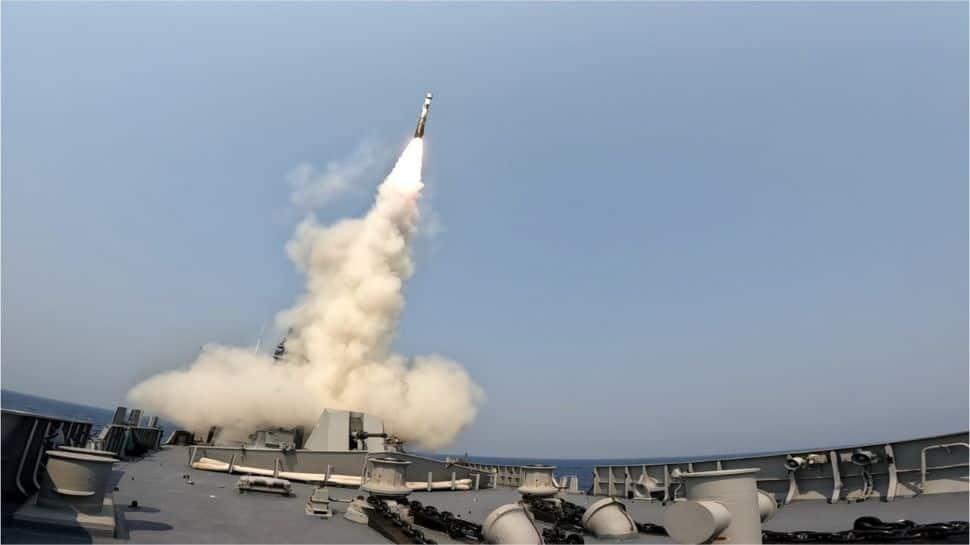Politics
India Tests 800-Kilometer BrahMos Missile, Heightening Regional Tensions

India has significantly advanced its military capabilities by testing the extended-range BrahMos supersonic cruise missile, which now boasts an impressive strike range of 800 kilometers. This development has raised concerns in Pakistan, as it enhances India’s ability to target adversarial positions deep within enemy territory with little to no warning.
According to the Defence Research and Development Organisation (DRDO), the current testing phase aims to ensure the missile’s operational readiness by the end of 2027. This missile is designed for conventional, non-nuclear warfare, marking a pivotal moment in India’s strategic military landscape. With this extended range, the Indian Armed Forces can engage targets that were previously beyond their reach.
Transforming Military Strategy
The BrahMos missile’s capabilities allow the Indian military to conduct strikes from distances that Pakistani defenses may struggle to counter. Originally designed for ground-to-ground attacks, the missile will soon be adapted for air and naval platforms. This shift grants India enhanced operational flexibility, enabling precision strikes from land, sea, and air.
The implications for regional security are profound. With the ability to engage critical targets in Pakistan, including military bases and terrorist camps, India can respond rapidly and accurately to perceived threats, potentially reshaping the strategic balance in South Asia.
Proven Effectiveness in Combat
India’s recent military operations illustrate the BrahMos missile’s effectiveness. During Operation Sindoor in May 2025, in retaliation for the Pahalgam terror attack, the Indian Air Force deployed BrahMos missiles launched from Sukhoi-30MKI fighter jets. These strikes successfully destroyed nine terrorist camps within Pakistan and Pakistan-occupied Kashmir, resulting in significant loss of life among militant groups such as Jaish-e-Mohammed and Lashkar-e-Taiba.
Defence Minister Rajnath Singh commended the BrahMos missile for its “pinpoint accuracy,” emphasizing its role in enhancing India’s strike capabilities. The operational success of BrahMos in these missions has garnered attention internationally, signaling a shift in military power dynamics in the region.
The missile’s speed is another critical factor in its effectiveness. Capable of traveling at speeds between Mach 2.8 and 3.0, the BrahMos presents a formidable challenge to enemy air defenses. By the time Pakistani radar systems detect an incoming missile, it is often too late to mount an effective response.
In previous engagements, Pakistan attempted to counter Indian strikes by deploying Chinese-made J-10 fighters armed with PL-15 beyond-visual-range missiles. However, these efforts fell short during Operation Sindoor, showcasing India’s superior tactics and indigenous technology.
As India continues to develop its military capabilities, the potential for increased regional tensions remains a pressing concern. The testing of the BrahMos missile underscores the shifting landscape of military power in South Asia, prompting both strategic recalibrations and heightened vigilance among neighboring nations.
-

 World5 months ago
World5 months agoSBI Announces QIP Floor Price at ₹811.05 Per Share
-

 Lifestyle5 months ago
Lifestyle5 months agoCept Unveils ₹3.1 Crore Urban Mobility Plan for Sustainable Growth
-

 Science4 months ago
Science4 months agoNew Blood Group Discovered in South Indian Woman at Rotary Centre
-

 World5 months ago
World5 months agoTorrential Rains Cause Flash Flooding in New York and New Jersey
-

 Top Stories5 months ago
Top Stories5 months agoKonkani Cultural Organisation to Host Pearl Jubilee in Abu Dhabi
-

 Sports4 months ago
Sports4 months agoBroad Advocates for Bowling Change Ahead of Final Test Against India
-

 Science5 months ago
Science5 months agoNothing Headphone 1 Review: A Bold Contender in Audio Design
-

 Top Stories5 months ago
Top Stories5 months agoAir India Crash Investigation Highlights Boeing Fuel Switch Concerns
-

 Business5 months ago
Business5 months agoIndian Stock Market Rebounds: Sensex and Nifty Rise After Four-Day Decline
-

 Sports4 months ago
Sports4 months agoCristian Totti Retires at 19: Pressure of Fame Takes Toll
-

 Politics5 months ago
Politics5 months agoAbandoned Doberman Finds New Home After Journey to Prague
-

 Top Stories5 months ago
Top Stories5 months agoPatna Bank Manager Abhishek Varun Found Dead in Well









